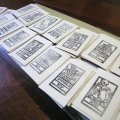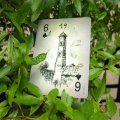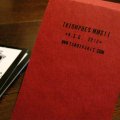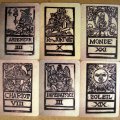Manufacturing

In order to stay as close as possible to the spirit and savoir faire of ancient cardmakers,the scarce minimum was sacrified to modern tools and materials. Technically speaking, only the linoleum and modern papers and use of a light powered heat source are anachronical compared to the works of ancient cardmakers. This quite luddite project is also a beat anachronical per se since all authentic traditional cardmakers are long gone since more than a hundred years.
Inspiration was found in fac similes, specialized litterature, collections from the Issy-Les-Moulineaux's Musée de la Carte à Jouer and from genuine XVIIIth century tarot cards my collector friend Yves let me handle and feel.
Apart for book researches, the computer was totally banned from all the process.
All drawing were traced - when drawn and not directly carved - with a graphite pen, directly on the plates and were then carved using traditional tools, chisels and gouges. The conditions and the target production being nothing to compare to a cardmaker manufacture, a few liberties were taken anyway to make that work possible.
The molds for instance were carved individually for each card then mounted on the plates. Furthermore, the size of cardmaker sheets of papers was not strictly followed, the sheets for this deck are of four cards, a smaller size much easier to handle in a reduced space. As said above, all the steps that needed heating used an electric heat source ; indeed maintaining a wood or coal fire was not an option in our modern city of Paris.
Modern heavy papers allow the creation of two sheets cards, as opposed to the four sheets or three sheets cards.
Manufacturing steps
Carving
Printing blocks - called mold for the cardmakers - are carved in relief, as any blockprinting technique. For the « triomphes de Paris », linoleum was favored over wood for ecological concerns (linoleum being a more sustainable ressource) as well as economical concerns ; technique and tools are identical in woodblock and linoleum printing, though.
Printing
Molds are grouped in six plates of four molds and printed with a press when printing or manually the traditional way following paper thickness. Printed sheets are then put to dry.
Assembling the cards
Glue is prepared following an ancient recipe involving mainly organic flour and water put to heat. Using thick and opaque backs afford to save the central "etresse" sheet between the face and the back.
Heating & Smoothing
Heating is made sheet by sheet on an electric plate. Smoothing is made by hand, sheet after sheet following the ancient method, although simplified as the traditional "lissoir" (a huge machine with wood, a stone and ropes) is replaced by a single metal piece and a lot of manual effot to compensate for the weight and strength.
Cutting
Each sheet is then cut one after the other, card by card.
Sorting and packing
The cards are sorted twice, checked back and side to eliminate faulty cards, they are then grouped by decks before being wrapped in an hand printed enveloppe (a folded sheet of light paper).
Technical description
Two sheets cards - dimensions : 9cm x 6 cm ; handprinted on medium heavy to heavy blockprinting paper (Velin d'Arches, Rives BFK, Lanaquarelle, etc according to available stocks) ; back : 330gr ecologic Maki brand "Natural" paper (chlorine free, non toxic, made in France) ; handmade vegetal glue following a recipe from the XVIIIth century ; vegetal ink based on (among other things) vegetal black, water and arabic gum ; smoothing handmade following cardmakers traditional methods.
No toxic varnishes, toxic glues nor aerosols are used.
Bibliography (shortened)
about techniques :
J.M Papillon, Traité historique et pratique de la gravure sur bois, tome premier et tome deuxième, chez Simon, Paris, 1766.
M.Duhamel de Monceau, "Art du Cartier" et "Art du Cartonnier", dans: Description des Arts et Métiers, collectif, Académie Royale des Sciences de Paris, Neuchatel, 1776.
collectif, Encyclopédié méthodique Arts et métiers mécaniques, tome premier, Paris, 1783.
Sieur Watin, L'art du Peintre, doreur, vernisseur, 4e édition, Paris, 1785.
collectif, Dictionnaire Technologique ou Nouveau dictionnaire des Arts et Métiers et de l'économie industrielle tome quatrième, chez Thomine et Fortic, Paris 1823.
M. Lebrun, Manuel du cartonnier, du cartier et du fabricant de cartonnages, à la librairie encyclopédique de Roret, Paris, 1830.
about playing cards and tarots :
Stuart R. Kaplan, Encyclopédie du Tarot, Tchou, Paris, 1978.
Thierry Depaulis, Tarot, jeu et magie, Bibliothèque Nationale, Paris, 1984.
collectif, Cartes à jouer et tarot de Marseille, Alors Hors du Temps, Marseille, 2004.
Jean-Marie Lhôte, Le symbolisme des jeux, Berg, Paris, 2010.
about Jacques Viéville's tarot in particular :
Charly Alverda, Trois figures hiéroglyphiques, Le Moulin de l'Étoile, Busloup, 2005.




